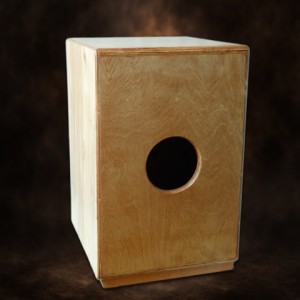 The cajon (the Spanish word for box) has been part of Afro-Peruvian music since the 19th century. This wonderful percussion instrument originated in colonial Peru, when the African slave drums had been forbidden by their masters. Undeterred and driven by the power of music they began using wooden boxes intended to hold fruits or overturned drawers to play their rhythms upon. Later the cajon was officially added to the instrumentation of the vals criollo, or “creole waltz.” It has now become a national emblem for Peruvians, and is an indispensable part of any ensemble that performs the traditional folk music of Peru.
The cajon (the Spanish word for box) has been part of Afro-Peruvian music since the 19th century. This wonderful percussion instrument originated in colonial Peru, when the African slave drums had been forbidden by their masters. Undeterred and driven by the power of music they began using wooden boxes intended to hold fruits or overturned drawers to play their rhythms upon. Later the cajon was officially added to the instrumentation of the vals criollo, or “creole waltz.” It has now become a national emblem for Peruvians, and is an indispensable part of any ensemble that performs the traditional folk music of Peru.
Many stories can also be found in Cuba about how cajons can be used as musical instruments by the marginalized masses. In the early 1960’s, Fidel Castro began getting nervous about the anti-Communist rallies forming in the streets, where masses were being drawn to the beat of drums and the sound of music. As most paranoid dictators do, Fidel “forbid” the playing of music in the streets in order to control the possibility of rebellion. The clever Cubans began to make drums from fruit boxes and other crude materials that one might find on any street. When the police arrived they would only find well behaved citizens sitting atop their fruit boxes and looking for work.
It has also been said that the cajon’s more recent development can be traced back to one man, the renowned flamenco guitar player Paco de Lucia. In the early 1970s, the Spanish embassy in Lima, Peru hosted a party for Paco de Lucia, at which they had a traditional Peruvian band perform utilizing the cajon. Flamenco music comprises many different rhythms which are normally played by the guitar player striking the body of the guitar. At that party, Paco de Lucia asked his former percussionist Ruben  Danta to play the
Danta to play the  “Buleria” on the cajon, which is one of the rhythms used in flamenco. Consequently, Paco de Lucia took the cajon with him back to Spain. The short staccato sounds that can be played on the cajon make it perfect for flamenco music, because that sound naturally relates to the footwork and hand-claps (“palmas”) used in Flamenco. Since the cajon’s historic migration from Peru to Spain, its use has spread worldwide.
“Buleria” on the cajon, which is one of the rhythms used in flamenco. Consequently, Paco de Lucia took the cajon with him back to Spain. The short staccato sounds that can be played on the cajon make it perfect for flamenco music, because that sound naturally relates to the footwork and hand-claps (“palmas”) used in Flamenco. Since the cajon’s historic migration from Peru to Spain, its use has spread worldwide.
Today’s cajon drum still follows the fundamental constructions and dimensions of the early cajon’s. Modern musicians however, being the master-tinkering types they are, have improvised and improved on much of the original – new designs add repurposed piano and/or guitar strings and drum snares to add a nice “sizzle” or “snare” effect. Most recently others have repurposed tambourine cymbals on the top left and right corners for a superb “clacking” effect
Written by Stanton Barker for C. B. Gitty Crafter Supply

love to slap with cajons, cool relaxing beat